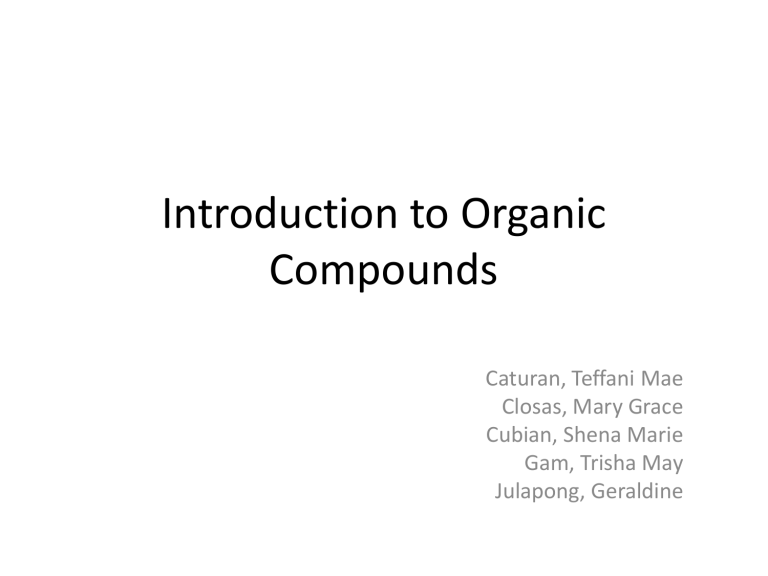Introduction to Organic Compounds
advertisement

Introduction to Organic Compounds Caturan, Teffani Mae Closas, Mary Grace Cubian, Shena Marie Gam, Trisha May Julapong, Geraldine LET’S PLAY! 1. A_ _o_ol 2. _th_r 3. B_nz_ _e 1. Alcohol 2. Ether 3. Benzene All substances can be classified as being either organic or inorganic. Originally, organic substances were considered to be those carbon compounds that were extracted from living things, while inorganic ones were compounds that did not originate in living systems. An organic compound is defined as a substance that contains the element “carbon”. However, some compounds that contain carbon are considered to be inorganic. A better definition may be that organic compounds have a carbon base, that carbon is the “backbone” of the compounds. Why are there so many organic compounds? Well, carbon atoms can attach themselves to each other in wide variety of ways. They can join together to form short or long chains, and they can form rings of many kinds, as well: The chains and rings can have branches and cross-links with atoms of other elements (mainly hydrogen) attached to the carbon atoms. Different arrangements of carbon atoms correspond to different compounds, and each compound has its own characteristic properties. We are going to approach the subject of organic chemistry in terms of organic nomenclature. Nomenclature involves the naming of compounds. We will restrict ourselves to the simpler organic compounds, because the more complex ones can get really complicated. You will be given a set of rules to follow as you name compounds. These rules must be followed very carefully. Success in learning organic nomenclature will involve some memorization on your part, but it will rely mainly on a logical approach to the problems presented. The second most abundant element found in organic compounds is hydrogen. This chapter will deal exclusively with compounds composed of only carbon and hydrogen. These are called 25-3 ©1997, A.J. Girondi hydrocarbons. These two elements can combine in countless ways. The structures of some hydrocarbons are shown below. The lines between the atomic symbols represent bonds. There are three types of carbon to carbon bonds:

